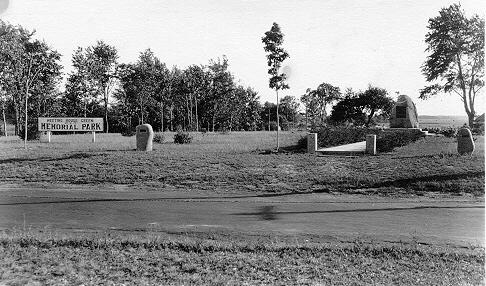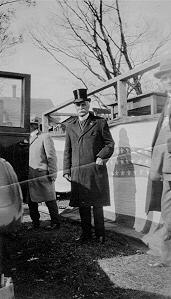By Brendan DuBois
Hampton Union, May 25, 1983

[Photo above]: This is how Founder’s Park looked soon after its dedication in 1925. The park was the idea of Rev. Ira S. Jones, who saw the park completed when he was 88 years old. It is dedicated to the memory of the original families of Hampton, who first settled here in 1688. This picture was provided by John Holman, curator of the Tuck Museum, 1983.
HAMPTON — Along Park Avenue there is a mystery, a triangular-shaped piece of land that is mostly empty, except for an odd arrangement of stones that stand in rows along the land’s three sides.
For the motorist driving quickly along one of three roads that borders the stone arrangement, the piece of land probably looks like an unusual graveyard or some eccentric playground.
To the pedestrian who walks past the stones and has more time to look at them, the mystery of what the arrangement means deepens, instead of being solved. In the center of the land {unreadable} dedicates the area as a memorial to the first settlers of Hampton, who settled near the park in 1638.
But there is nothing in the park that explains the 42 small stones lined up in a triangular row, or the nine larger stones at the three corners of the park. The smaller stones have plaques bearing names: Lane, Nudd, Sanborn, Prescott …. The nine larger stones also bear names, but they are carved in the base of the stones and are almost hidden by the grass. And the names are not those of people, but of towns: Hampton, North Hampton, East Kingston, Kingston …..
The stones stand silent, but to someone who knows what they are and what they mean, the mysterious stones speak volumes about the history and dedication of some of Hampton’s citizens.

The park’s official name is the Meeting House Green Memorial Park, but it is more commonly known as the Memorial Park or Founder’s Park. The history of the park began in the 1920s as the idea of Rev. Ira S. Jones, according to John Holman, curator of the Tuck Memorial Museum and a member of the Meeting House Green Memorial Historical Association (known as the Hampton Historical Society).
Although not a native of Hampton, Jones fell in love with the town after visiting it and then moving here. He also became fascinated with the background of the town, reading and re-reading Dow’s History of Hampton. Jones then decided something should be done to commemorate the first settlers and their families who came to the wilderness that was New Hampshire in 1638.
“He saw the triangular plot of land and he got the idea that it would be a good place for a memorial to the founders of Hampton,” Holman said.
Work on the park started in 1924, and Jones received a lot of financial assistance from Edward Tuck, who lived in Paris and whose descendant, Robert Tuck, was one of the original settlers of Hampton, which was first known as Winnacunnet.
It took some work to clear the plot of land and prepare the memorial stones, and Holman said, Jones, even though he was 88 years old, did a lot of the heavy work himself.
“He didn’t stand back and watch the workers do all of the work,” Holman said.
The park was finished within a year and was dedicated in an elaborate ceremony on Oct. 14, 1925. Jones, who was instrumental in setting up the Tuck Memorial Museum, the historical society, the Hampton Cemetery Association and Tuck Field, died two years later after the park was dedicated.
Although the stones at the park were erected at the same time, They commemorate three different things.
The center stone, which weighs 12 tons, has a plaque that recalls the first group of settlers who came to New Hampshire under the leadership of Rev. Stephen Bachiler of Southampton, England. The stone is also the site where a time capsule was buried in 1925 after the dedication, and which was later opened in 1975.
The perimeter stones bearing the names of families, commemorate the founding families of Hampton, and the stones on the corner remember Hampton and eight of the town’s nine “Daughter Towns”, those towns that originally part of Hampton.
Those towns included North Hampton, Seabrook, Hampton Falls, Danville, Sandown, Kensington, Kingston, East Kingston and Rye. Those towns broke away from Hampton during the 1700s, except for Kingston, which became a separate town in 1690.
“Jones went before the selectmen of the surrounding towns and got them to agree to donate a stone bearing their name,” Holman said. “But for some reason there is no stone for Rye.”
Holman said the park has remained fairly unchanged since its founding in 1925, and he said eventually he expects a stone for Rye will be installed (which it was years later).
“It’s a unique park,” Holman said “I haven’t heard of anything like this